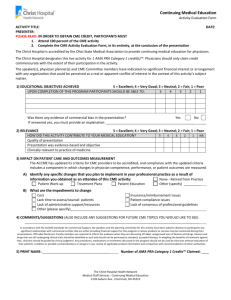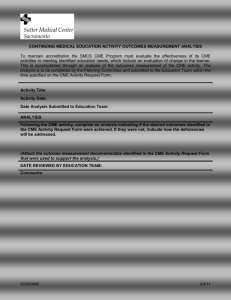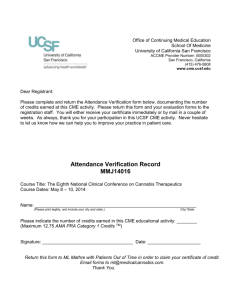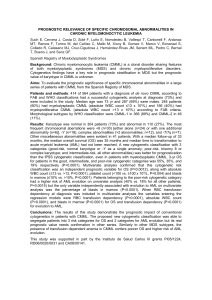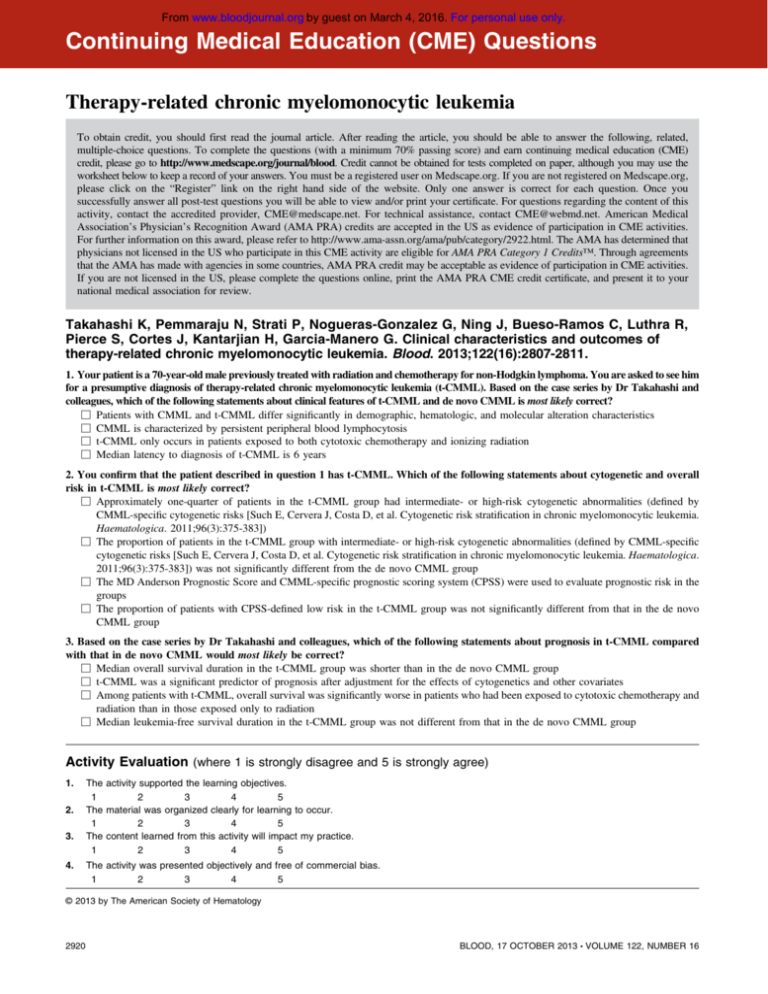
From www.bloodjournal.org by guest on March 4, 2016. For personal use only.
Continuing Medical Education (CME) Questions
Therapy-related chronic myelomonocytic leukemia
To obtain credit, you should first read the journal article. After reading the article, you should be able to answer the following, related,
multiple-choice questions. To complete the questions (with a minimum 70% passing score) and earn continuing medical education (CME)
credit, please go to http://www.medscape.org/journal/blood. Credit cannot be obtained for tests completed on paper, although you may use the
worksheet below to keep a record of your answers. You must be a registered user on Medscape.org. If you are not registered on Medscape.org,
please click on the “Register” link on the right hand side of the website. Only one answer is correct for each question. Once you
successfully answer all post-test questions you will be able to view and/or print your certificate. For questions regarding the content of this
activity, contact the accredited provider, CME@medscape.net. For technical assistance, contact CME@webmd.net. American Medical
Association’s Physician’s Recognition Award (AMA PRA) credits are accepted in the US as evidence of participation in CME activities.
For further information on this award, please refer to http://www.ama-assn.org/ama/pub/category/2922.html. The AMA has determined that
physicians not licensed in the US who participate in this CME activity are eligible for AMA PRA Category 1 Credits™. Through agreements
that the AMA has made with agencies in some countries, AMA PRA credit may be acceptable as evidence of participation in CME activities.
If you are not licensed in the US, please complete the questions online, print the AMA PRA CME credit certificate, and present it to your
national medical association for review.
Takahashi K, Pemmaraju N, Strati P, Nogueras-Gonzalez G, Ning J, Bueso-Ramos C, Luthra R,
Pierce S, Cortes J, Kantarjian H, Garcia-Manero G. Clinical characteristics and outcomes of
therapy-related chronic myelomonocytic leukemia. Blood. 2013;122(16):2807-2811.
1. Your patient is a 70-year-old male previously treated with radiation and chemotherapy for non-Hodgkin lymphoma. You are asked to see him
for a presumptive diagnosis of therapy-related chronic myelomonocytic leukemia (t-CMML). Based on the case series by Dr Takahashi and
colleagues, which of the following statements about clinical features of t-CMML and de novo CMML is most likely correct?
M Patients with CMML and t-CMML differ significantly in demographic, hematologic, and molecular alteration characteristics
M CMML is characterized by persistent peripheral blood lymphocytosis
M t-CMML only occurs in patients exposed to both cytotoxic chemotherapy and ionizing radiation
M Median latency to diagnosis of t-CMML is 6 years
2. You confirm that the patient described in question 1 has t-CMML. Which of the following statements about cytogenetic and overall
risk in t-CMML is most likely correct?
M Approximately one-quarter of patients in the t-CMML group had intermediate- or high-risk cytogenetic abnormalities (defined by
CMML-specific cytogenetic risks [Such E, Cervera J, Costa D, et al. Cytogenetic risk stratification in chronic myelomonocytic leukemia.
Haematologica. 2011;96(3):375-383])
M The proportion of patients in the t-CMML group with intermediate- or high-risk cytogenetic abnormalities (defined by CMML-specific
cytogenetic risks [Such E, Cervera J, Costa D, et al. Cytogenetic risk stratification in chronic myelomonocytic leukemia. Haematologica.
2011;96(3):375-383]) was not significantly different from the de novo CMML group
M The MD Anderson Prognostic Score and CMML-specific prognostic scoring system (CPSS) were used to evaluate prognostic risk in the
groups
M The proportion of patients with CPSS-defined low risk in the t-CMML group was not significantly different from that in the de novo
CMML group
3. Based on the case series by Dr Takahashi and colleagues, which of the following statements about prognosis in t-CMML compared
with that in de novo CMML would most likely be correct?
M Median overall survival duration in the t-CMML group was shorter than in the de novo CMML group
M t-CMML was a significant predictor of prognosis after adjustment for the effects of cytogenetics and other covariates
M Among patients with t-CMML, overall survival was significantly worse in patients who had been exposed to cytotoxic chemotherapy and
radiation than in those exposed only to radiation
M Median leukemia-free survival duration in the t-CMML group was not different from that in the de novo CMML group
Activity Evaluation (where 1 is strongly disagree and 5 is strongly agree)
1.
2.
3.
4.
The activity supported the learning objectives.
1
2
3
4
5
The material was organized clearly for learning to occur.
1
2
3
4
5
The content learned from this activity will impact my practice.
1
2
3
4
5
The activity was presented objectively and free of commercial bias.
1
2
3
4
5
© 2013 by The American Society of Hematology
2920
BLOOD, 17 OCTOBER 2013 x VOLUME 122, NUMBER 16
From www.bloodjournal.org by guest on March 4, 2016. For personal use only.
2013 122: 2920
doi:10.1182/blood-2013-09-525832
Therapy-related chronic myelomonocytic leukemia
Updated information and services can be found at:
http://www.bloodjournal.org/content/122/16/2920.citation.full.html
Articles on similar topics can be found in the following Blood collections
CME article (144 articles)
Information about reproducing this article in parts or in its entirety may be found online at:
http://www.bloodjournal.org/site/misc/rights.xhtml#repub_requests
Information about ordering reprints may be found online at:
http://www.bloodjournal.org/site/misc/rights.xhtml#reprints
Information about subscriptions and ASH membership may be found online at:
http://www.bloodjournal.org/site/subscriptions/index.xhtml
Blood (print ISSN 0006-4971, online ISSN 1528-0020), is published weekly by the American Society
of Hematology, 2021 L St, NW, Suite 900, Washington DC 20036.
Copyright 2011 by The American Society of Hematology; all rights reserved.



